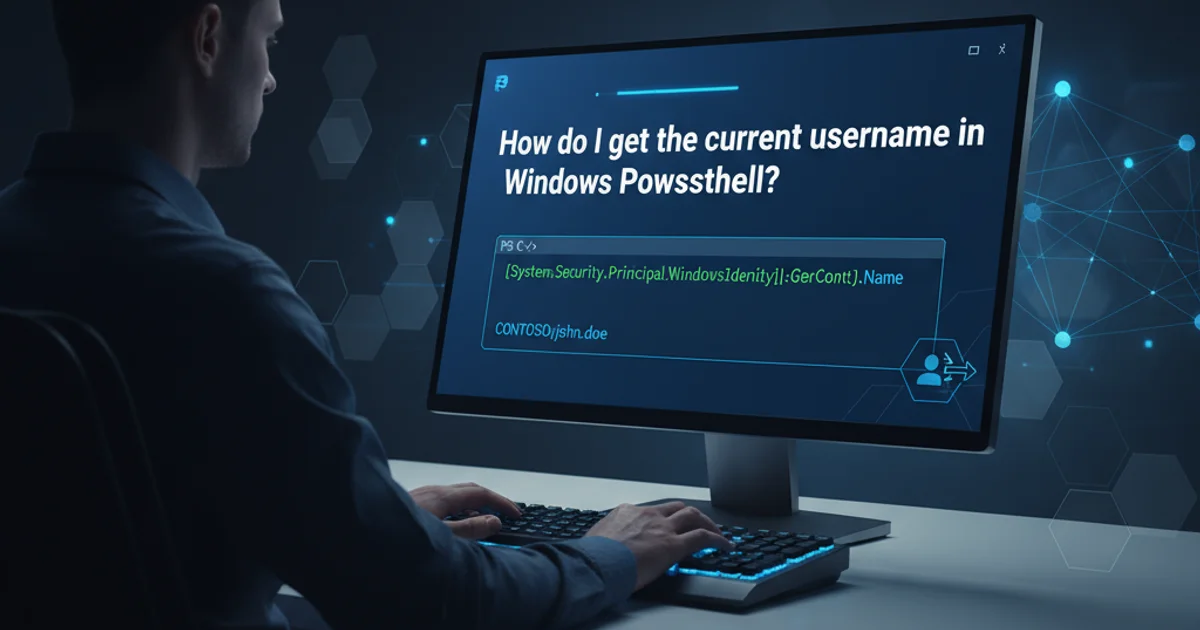How do I get the current username in Windows PowerShell?
Categories:
How to Get the Current Username in Windows PowerShell

Learn various methods to retrieve the current logged-in username in Windows PowerShell, from simple environment variables to detailed WMI queries.
Identifying the current user is a fundamental task in scripting and system administration. Whether you're logging actions, personalizing scripts, or enforcing permissions, knowing who is running a PowerShell script is crucial. This article explores several robust methods to obtain the current username in Windows PowerShell, catering to different needs and levels of detail.
Method 1: Using Environment Variables
The simplest and often most direct way to get the current username is by accessing environment variables. Windows maintains several environment variables that store information about the current user session. The $env:USERNAME variable is specifically designed for this purpose.
$env:USERNAME
Retrieving username using the USERNAME environment variable
This method returns just the username (e.g., jsmith). If you need the domain and username (e.g., DOMAIN\jsmith), you can use $env:USERDOMAIN in conjunction with $env:USERNAME or directly use $env:USERDNSDOMAIN for the fully qualified domain name.
$env:USERDOMAIN + '\' + $env:USERNAME
$env:USERDNSDOMAIN + '\' + $env:USERNAME
Getting domain and username using environment variables
Method 2: Using the [System.Security.Principal.WindowsIdentity] Class
For more detailed user information, especially when dealing with security contexts or impersonation, the [System.Security.Principal.WindowsIdentity] class provides a powerful object. This class allows you to retrieve the current user's identity, including their security identifier (SID) and authentication type.
[System.Security.Principal.WindowsIdentity]::GetCurrent().Name
Getting the current user's full name (domain\username) using WindowsIdentity
This method returns the username in the format DOMAIN\Username or COMPUTERNAME\Username for local accounts. You can also access other properties of the WindowsIdentity object:
$currentUser = [System.Security.Principal.WindowsIdentity]::GetCurrent()
$currentUser.Name
$currentUser.User.Value # Get the SID
$currentUser.AuthenticationType
Exploring properties of the WindowsIdentity object
flowchart TD
A[Start PowerShell Script] --> B{Retrieve User Identity}
B --> C["Call [System.Security.Principal.WindowsIdentity]::GetCurrent()"]
C --> D{Access .Name Property}
D --> E[Output: DOMAIN\Username]
C --> F{Access .User.Value Property}
F --> G[Output: User SID]
C --> H{Access .AuthenticationType Property}
H --> I[Output: Authentication Type]
E & G & I --> J[End]Flowchart for retrieving user identity details using WindowsIdentity
Method 3: Using whoami Command (External Executable)
While not a native PowerShell cmdlet, the whoami command is a standard Windows utility that can be executed from PowerShell. It provides information about the current user and their group memberships. This method is useful if you're familiar with command-line tools or need to quickly verify the user context.
whoami
Executing the whoami command
The output of whoami is typically DOMAIN\username. You can also use switches to get more specific information, such as /user for the SID or /groups for group memberships.
whoami /user
whoami /groups
Using whoami with switches for detailed information
whoami can be slightly slower than native PowerShell methods and might require parsing string output, which can be less robust than working with objects.Method 4: Using Get-WmiObject (or Get-CimInstance)
For a more programmatic and object-oriented approach, especially when querying remote systems or needing specific user session details, Windows Management Instrumentation (WMI) is a powerful option. The Win32_ComputerSystem class can provide the username of the currently logged-on user.
(Get-WmiObject -Class Win32_ComputerSystem).UserName
Retrieving username using Get-WmiObject
This command returns the username in the DOMAIN\Username format. For modern PowerShell versions (5.0+), Get-CimInstance is the recommended cmdlet over Get-WmiObject.
(Get-CimInstance -ClassName Win32_ComputerSystem).UserName
Retrieving username using Get-CimInstance